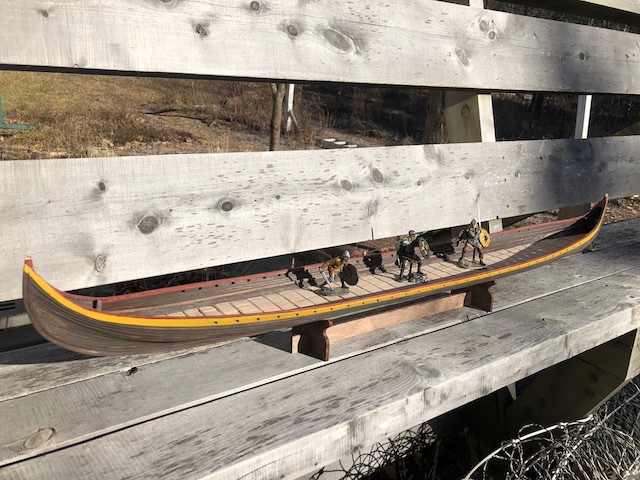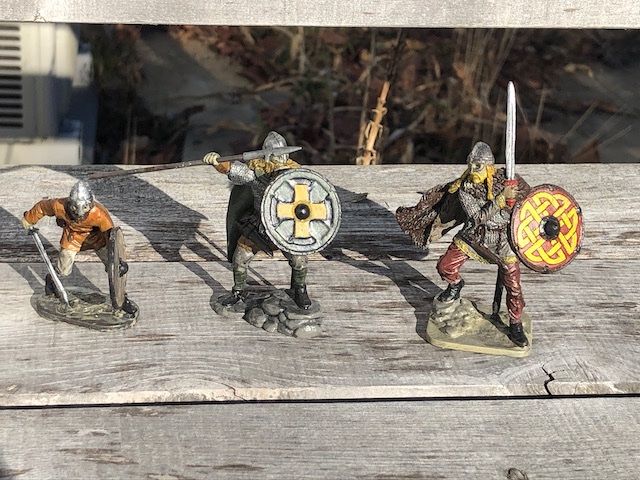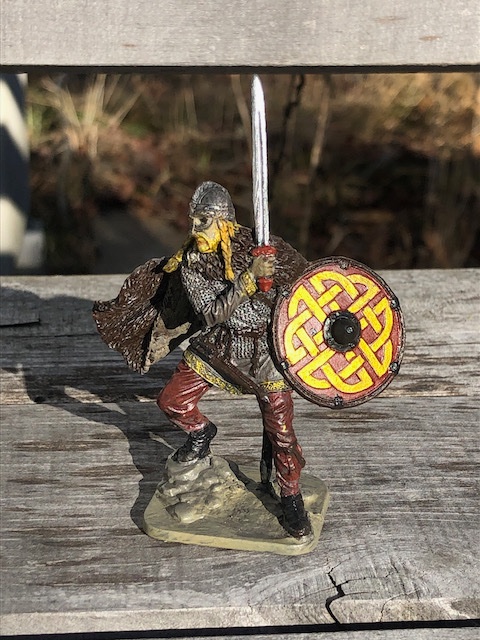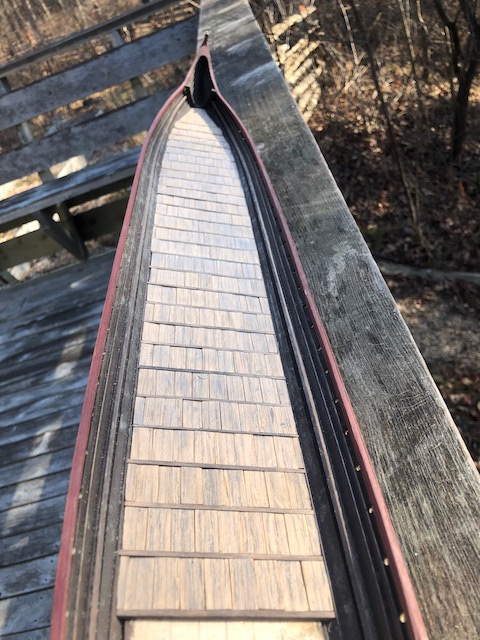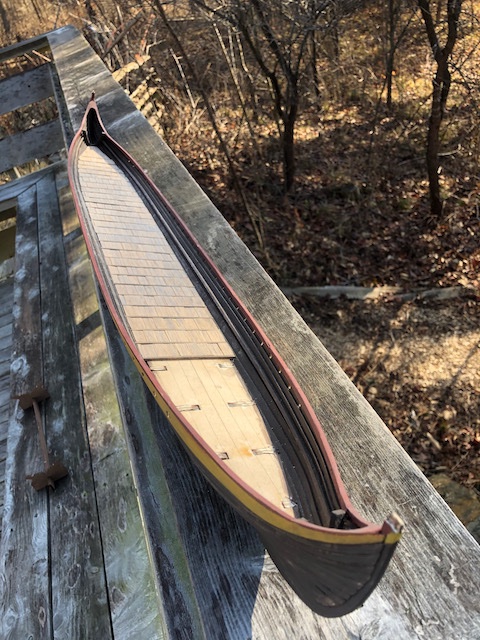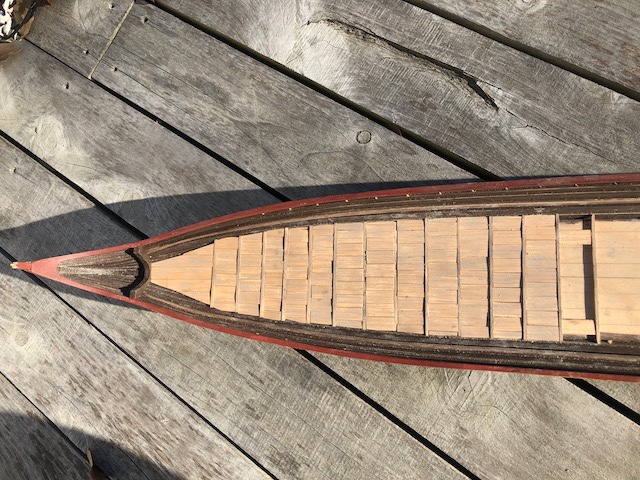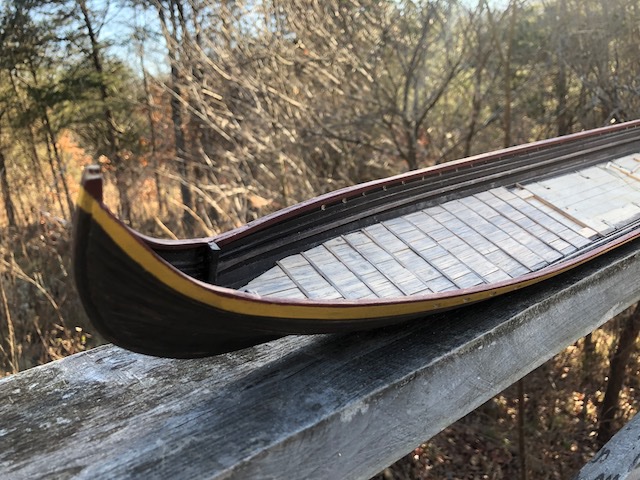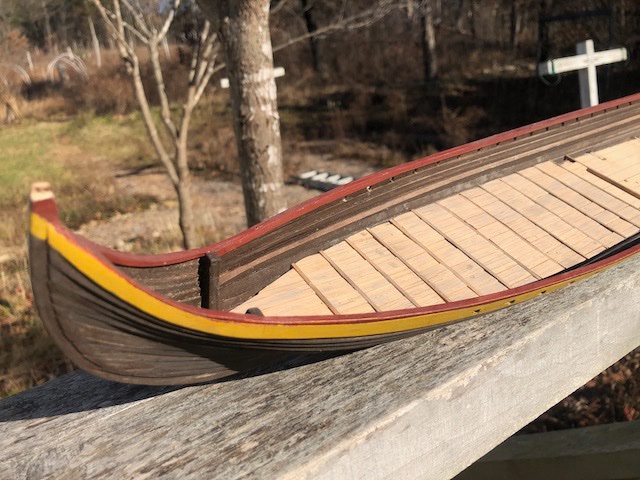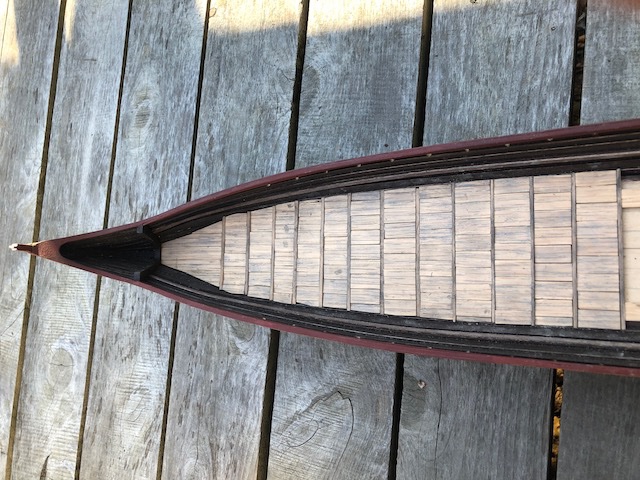-
Posts
3,532 -
Joined
-
Last visited
Content Type
Profiles
Forums
Gallery
Events
Everything posted by Cathead
-
Wow, that thing is huge! Quite a bit bigger than Skuldelev 2. Petr is right, it's not a specific reproduction and in fact seems to combine styles and ideas multiple eras to create a sort of idealized craft. For comparison (figures from sites linked below): Dragon Harald Fairhair (ship in the video) 115' (35 m) long 26' (8 m) wide displaces 80 t sail area of 260 square m crew of at least 100 Skuldelev 2 98' (30 m) long 12' (3.8 m) wide displaces 26 t sail area of 112 square m crew of around 70 Thanks for sharing that video, it was a nice overview of various steps taken in construction. As for the current project, the deck is done! I rewarded myself by painting the third figure. Meet Sigtryggr, again named for a character from the Saxon Tales books but this time also a real historical figure. The real Sigtryggr was a Norseman who ruled in both Dublin and Northumbria, the former making him especially appropriate for this version of Skuldelev 2 (which was built near Dublin, though over 100 years after Sigtryggr's time). He's the most ornate and wealthiest of the three figures I've acquired, with his fur cloak, fancy shield, and cloak with embroidered linings. I tried to match his color scheme to the ship's. Here are all three figures: And here they are on the completed deck: This was a nice milestone to reach. Not sure what I'm going to work on next, but thanks for sticking with me.
-
Excellent! The rounded sides of the "look-in" really work well, and the second round of carriages is a definite improvement. Happy Holidays to you too!
-
The deck is mostly completed. I still haven't decided what to do about riveting. Leaning toward not bothering, as I'm just not sure I can do it right (or have the patience to do it right) and would rather it not be present than do in a poor, distracting way.
-
What a fantastic project! I'm quite interested in traditional Chinese cultures as I work with many Chinese authors in my capacity as a scientific editor. My last scratchbuild also attempted to reconstruct a vessel about which little was known above the hull, so I have some appreciation for the complex research and decisions involved (though yours will be far more difficult). I'm struck by how much those planking cross-sections look like a clinker-built Viking longship. Obviously the bulkheads don't match, but the profile is quite reminiscent.
-
Brian, The park may be closed to visitors but staff may still be working or at least available. The core NPS jobs are permanent hires, it's not like everyone's been let go, and they can't just shut the gates and ignore everything. So there's a decent chance someone is still monitoring contact info and could get back to you. They give basic contact info (phone # and an email form) at the link below, could try that and see if anyone responds. If you can make contact, the rest might work as the right staff member might be able to pass you along to the right historian or whoever. https://www.nps.gov/vick/contacts.htm
-
Great to hear from you again. Always nice when a modeler returns from hiatus. She certainly looks nice.
- 53 replies
-
- rattlesnake
- model shipways
-
(and 1 more)
Tagged with:
-
Have you tried contacting the museum with this question? Current staff may not know, but they may well be able to reach out to someone who does.
-
Nice rapid start on a very interesting prototype.
- 208 replies
-
- kitbashing
- Woodcarving
-
(and 4 more)
Tagged with:
-
I just stumbled across this fascinating build and so will jump in late. Great start with such an interesting and unique vessel.
- 179 replies
-
- longship
- Helga Holm
-
(and 1 more)
Tagged with:
-
Maybe you'll do a better job than me! Certainly there are things I'd do differently if I were to repeat my kit.
- 48 replies
-
- dusek
- viking knarr
-
(and 1 more)
Tagged with:
-

Chaperon by joep4567 - 1:48 - Sternwheeler
Cathead replied to joep4567's topic in - Build logs for subjects built 1801 - 1850
Depending on how crazy you're feeling, there can be a variety of pulls hanging from the ceiling (connecting to the engine room, for example), speaking tubes, a spittoon, etc. One especially visible detail would be the long wooden lever used to "lock" the wheel in place if the pilot needs to step away (called the bridle, I believe). -

Chaperon by joep4567 - 1:48 - Sternwheeler
Cathead replied to joep4567's topic in - Build logs for subjects built 1801 - 1850
Creative way to get around having to drop the lower part of the wheel through the floor. All looks good. What other details are you planning? -
Seems to me that a topsail schooner could be a good choice. It's a step up in complexity from the Armed Virginia Sloop, so would be a new challenge. Lots of blockade runners and smugglers used such craft. You could adapt something like BlueJacket's Revenue Cutter to play for the opposing team, so to speak.
-
Good question. I don't know, but my guesses include (a) not directly exposed to seawater, (b) easily replaceable so why waste the tar, and (c) the deck isn't meant to be sealed like the outer hull. I also wonder what the texture of tarred wood was like, and whether it would be more difficult to walk on.
-
More decking progress. I took paired photos in sun and shade as each highlights different aspects of the texture and color. Really pleased with how this is coming out: This is a great task to just keep plugging away at in free moments. It's a lot of manual work but pretty straightforward now that I have my system perfected. Probably another week or two and it'll be done.
-
Welcome! I'm currently building the 1:35 Dusek longship (see link in signature), another case where no log exists for the large-scale version, only the 1:72 version. I've found the kit to be rather problematic and you may well benefit from reading through my frustrations, mistakes, and solutions, even if you proceed differently, as I wouldn't be surprised to find many issues mirrored between the two kits. I hope you'll stick with it; mine is finally starting to look like something and I think will turn out well. Good luck and I look forward to seeing what you do with this interesting vessel.
- 48 replies
-
- dusek
- viking knarr
-
(and 1 more)
Tagged with:
-
I feel that he's generally good about the broad context but has gotten ever-sloppier with the details as the series goes on. For Pillars, my understanding is that he plunged into the details of period cathedral building and it comes through in the narrative. In the later books, he takes less time to understand what he's talking about and just writes the same story with the same characters with a few details changed to hint at a different era. But never once do you get the sense that he dove as deeply in the context of the others as he did for Pillars. Pillars is also the only one where there's really a deeper literary narrative behind the character arcs (the mystery of Jack Shareburg) that ties all the character arcs together in a creative and powerful way by the end. I noticed the same things Roger did (laughable maritime scenes, "Lenny", various other strange and awkward stuff). Absolutely "winging it" in an effort to churn out the next best-selling potboiler rather than writing an actual work of literature (which Pillars aspires to and generally achieves). He does the same, even worse, in E&M. If you all want a really interesting, highly detailed, fascinating, and compelling historical novel set deeply within English history, try An Instance of the Fingerpost. It tells the story of a mystery in 1600s Oxford, sequentially from four points of view, tying in a vast set of knowledge drawn from the religious, scientific, and political tumult of the period. Just about the best-crafted historical novel I've ever read and one that really needs to be read multiple times to fully appreciate how many threads he's weaving together.
-
Pillars is by far the best, an excellent book that stands up to repeated rereads (at least four for me). I'll never read the others again. As with many authors, he got it right once, then started cashing in on the formula with predictable results in terms of quality. I mean, I've read them all, he obviously writes stories that draw readers in. But each successive book felt less compelling. E&M, for example, might work ok if you hadn't read any of the others, but by that point he's following some pretty deep narrative ruts and all the characters are recognizable as reflections of the same cutouts in previous books. And, most damning to me, E&M never once feels like it takes place in its intended era. It's just recycled Pillars with a few vague references to Vikings thrown in, along with a laughably silly "battle". Any literary criticism is opinion-based, and we're all entitled to feel differently. Others' mileage may vary.
-
Honestly, though Follett can spin a good yarn, if you know much about the periods he's describing the books go rapidly off the rails. Don't read The Evening and the Morning (the new prequel to that series) if you know anything about the Anglo-Saxon/Viking period, your eyes will roll out of your head. There are far more accurate historical writers out there who can still spin a yarn (such as Bernard Cornwell).
-
Thanks very much, folks. My FIL and I were not only close, but ludicrously similar (both Northerners who ended up as freelance editors on rural Southern homesteads with large gardens, both deeply interested in the full spread of natural science and human history, both married to strong, intelligent women who love the outdoors, etc.). We even shared some of the same faults, which he certainly had but which I won't go into here (nor the differences). But it was enough for a strong affinity, especially as I lost my own father in high school. Brian, right now I like the hull as it is, but may reconsider a bit more weathering when I'm done with the internal details. I might want to blend the visual style together more when I see what I've done to the interior.
About us
Modelshipworld - Advancing Ship Modeling through Research
SSL Secured
Your security is important for us so this Website is SSL-Secured
NRG Mailing Address
Nautical Research Guild
237 South Lincoln Street
Westmont IL, 60559-1917
Model Ship World ® and the MSW logo are Registered Trademarks, and belong to the Nautical Research Guild (United States Patent and Trademark Office: No. 6,929,264 & No. 6,929,274, registered Dec. 20, 2022)
Helpful Links
About the NRG
If you enjoy building ship models that are historically accurate as well as beautiful, then The Nautical Research Guild (NRG) is just right for you.
The Guild is a non-profit educational organization whose mission is to “Advance Ship Modeling Through Research”. We provide support to our members in their efforts to raise the quality of their model ships.
The Nautical Research Guild has published our world-renowned quarterly magazine, The Nautical Research Journal, since 1955. The pages of the Journal are full of articles by accomplished ship modelers who show you how they create those exquisite details on their models, and by maritime historians who show you the correct details to build. The Journal is available in both print and digital editions. Go to the NRG web site (www.thenrg.org) to download a complimentary digital copy of the Journal. The NRG also publishes plan sets, books and compilations of back issues of the Journal and the former Ships in Scale and Model Ship Builder magazines.


